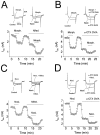Axotomy reduces the effect of analgesic opioids yet increases the effect of nociceptin on dorsal root ganglion neurons
- PMID: 9822729
- PMCID: PMC6793289
- DOI: 10.1523/JNEUROSCI.18-23-09685.1998
Axotomy reduces the effect of analgesic opioids yet increases the effect of nociceptin on dorsal root ganglion neurons
Abstract
There is some doubt as to the effectiveness of opioids in the management of neuropathic pain. We therefore examined the actions of morphine and the opioid-like peptide nociceptin (both 1 mu) on dorsal root ganglion (DRG) neurons that were isolated from control or from nerve-injured rats. Both substances reduced omega-conotoxin (CTX) GVIA-sensitive, N-type Ca2+ channel current and small persistent nifedipine/ CTX-insensitive (non-N, non-L type) current. Nifedipine-sensitive L-type current was unaffected. The effect of nociceptin was antagonized by naloxone benzoylhydrazone (nalbzoh) but not by naloxone. Sciatic nerve section (axotomy) profoundly reduced the effects of morphine and the mu-receptor agonist D-ala2, N-Me-Phe4,Gly-ol5 enkephalin (DAMGO). The effect of the kappa-agonist [(+)-(5alpha,7alpha, 8beta)-N-methyl-N-(7-(1-pyrrolidinyl)-1-oxaspiro(4, 5)dec-8-yl)-benzeneacetamide] (U69593) was unchanged, whereas the effect of nociceptin was increased. All agonists produced their strongest effects on the small, putative nociceptive cells and their weakest effects on the largest cells. The delta-receptor agonist, enkephalin D-pen2,5 (DPDPE), was without effect on control or on axotomized cells. These and other data suggest that the functional downregulation of mu-opioid receptors on sensory nerves contributes to the poor efficacy of opioids in neuropathic pain. Also, the increased effectiveness of nociceptin after axotomy supports the hypothesis that its actions are mediated via a "non-opioid" receptor. Pronounced suppression of Ca2+ channel current in axotomized DRG neurons by nociceptin led to a reduction in Ca2+-dependent K+ conductance and a marked increase in excitability. Despite this, the spinal administration of nociceptin or agonists that activate ORL1 (opioid-like orphan receptor) may prove to be of clinical interest in the management of neuropathic pain.
Figures





References
-
- Abdulla FA, Smith PA. Differential effects of axotomy on the sensitivity of dorsal root ganglion (DRG) cells to morphine and nociceptin. Soc Neurosci Abstr. 1997c;23:1016.
-
- Abdulla FA, Smith PA (1999) Nerve injury increases an excitatory action of neuropeptide Y and Y2-agonists on dorsal root ganglion cells. Neuroscience, in press. - PubMed
-
- Akins PT, McCleskey EW. Characterization of potassium currents in adult rat sensory neurons and modulation by opioids and cyclic AMP. Neuroscience. 1993;56:759–769. - PubMed
Publication types
MeSH terms
Substances
LinkOut - more resources
Full Text Sources
Other Literature Sources
Research Materials
Miscellaneous
